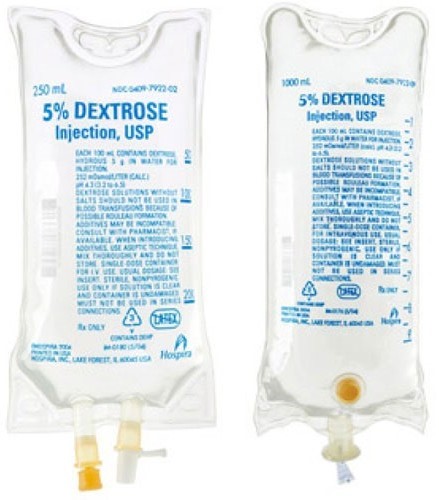A patient is receiving an IV of 500 mL of D5W (dextrose 5% in water).
How many grams (g) of dextrose are contained in this IV solution?
10g
25g
50g
100g
The Correct Answer is B
Dextrose 5% in water (D5W) is an IV fluid that contains **5 grams of dextrose** per 100 mL of water². To calculate how many grams of dextrose are in 500 mL of D5W, you can use a simple proportion:
5 g / 100 mL = x g / 500 mL
Cross-multiply and solve for x:
x = (5 g * 500 mL) / 100 mL
x = 25 g
Therefore, there are **25 grams of dextrose** in 500 mL of D5W.

Nursing Test Bank
Naxlex Comprehensive Predictor Exams
Related Questions
Correct Answer is B
Explanation
The correct angle for giving an intradermal injection is **10 to 15 degrees**. This angle allows the needle to enter the dermis, which is the layer of skin just below the epidermis. The needle should be inserted almost flat against the patient's skin, with the bevel side up. A small blister or bleb should form under the skin after injecting the medication.

Correct Answer is C
Explanation
To find the milliliters per minute, you need to calculate the following:
- The volume of Lopressor in milliliters
- The infusion rate in milliliters per minute using the formula: Infusion rate (mL/min) = Total volume (mL) / Time (min)
First, divide the dose of Lopressor by the concentration to get the volume in milliliters:
5 mg / 1 mg/mL = 5 mL
Next, use the formula for infusion rate to find how many milliliters per minute the IV pump should deliver:
Infusion rate (mL/min) = Total volume (mL) / Time (min)
Since the total volume is 5 mL and the time is 60 seconds or 1 minute, plug in these values into the formula:
Infusion rate (mL/min) = 5 mL / 1 min
Simplify and solve for the infusion rate:
Infusion rate (mL/min) = 5 mL/min
Therefore, the nurse should administer **5 mL/min** to infuse Lopressor 5 mg over 60 seconds.
Whether you are a student looking to ace your exams or a practicing nurse seeking to enhance your expertise , our nursing education contents will empower you with the confidence and competence to make a difference in the lives of patients and become a respected leader in the healthcare field.
Visit Naxlex, invest in your future and unlock endless possibilities with our unparalleled nursing education contents today
Report Wrong Answer on the Current Question
Do you disagree with the answer? If yes, what is your expected answer? Explain.
Kindly be descriptive with the issue you are facing.
